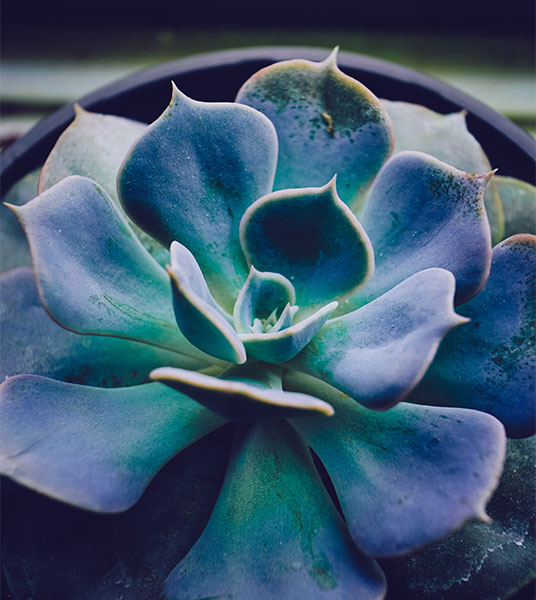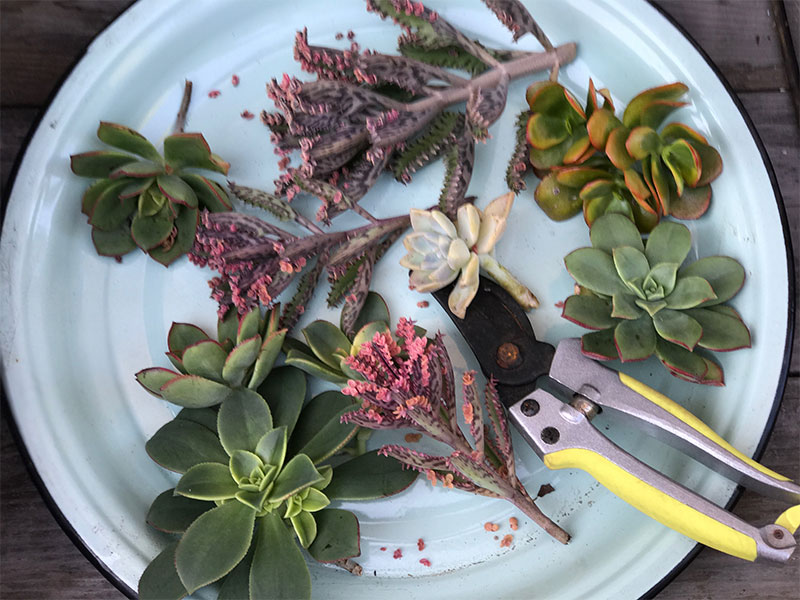Echeveria Agavoides, affectionately termed as the 'Blue Bird', stands out as a gem in the succulent world. Its striking appearance, characterized by vibrant colors and a distinctive, sculptural form, makes it a favorite among indoor plant enthusiasts. Embraced for its minimal care requirements, the Blue Bird offers an enriching gardening journey, even for beginners. Let's dive into an in-depth guide that will lead you through the rewarding process of nurturing a flourishing Echeveria Blue Bird in the comfort of your home.
The Essence of Echeveria Agavoides
Echeveria Agavoides, or commonly known as "Echeveria Blue Bird," is a remarkable succulent plant that possesses unique characteristics at its core. This captivating plant showcases a distinctive rosette pattern, with its leaves forming a tightly packed circular arrangement. These leaves are an integral part of what makes Echeveria Agavoides so fascinating. The leaves of Echeveria Agavoides are pointed, and they gracefully curve inwards towards the center of the rosette. These leaves exhibit a mesmerizing color transition that adds to their allure.
However, the color change in Echeveria Agavoides is not merely for aesthetic purposes; it also serves as a testament to the garden plants' adaptive nature. The ability to change color in response to sunlight is a survival strategy employed by many succulents, including Echeveria Agavoides. This adaptive trait allows the plant to regulate its exposure to sunlight, helping it thrive in different environmental conditions.
Tailored Care for Optimal Growth
Basking in Light: The Solar Embrace
Echeveria 'Blue Bird' succulents are truly a sight to behold when bathed in bright sunlight. The bright sunlight is like an elixir that enhances their vivid hues. Whether you're planting them outdoors or nurturing them in your indoor garden, providing the right amount of direct sunlight is crucial for their optimal growth.
In regions with a warm climate matching the native hardiness zone of this plant, 'Blue Bird' succulents are in their element. They thrive under the gentle caress of the sun's rays, showcasing their vibrant and alluring colors. However, what if you find yourself in a cooler area where outdoor cultivation poses a challenge? Fear not, for there's a fantastic solution to keep your succulent thriving indoors – the Mars Hydro VG40 and VG80 LED grow lights.
These state-of-the-art LED grow lights have become an essential tool for modern gardeners. They're like the best friend of your indoor garden, providing not just illumination but also rejuvenation to your beloved 'Blue Bird' succulent.
What makes Mars Hydro VG40 and VG80 LED grow lights suitable for the cultivation of succulents? Here's why:
1. Spectrum Tuned for Growth: These LED grow lights provide the ideal spectrum of light, including blue and red wavelengths, which are essential for photosynthesis and plant growth. They are designed to meet the specific light requirements of succulents like 'Blue Bird.'
2. Energy Efficiency: Mars Hydro VG40 and VG80 LED grow lights are energy-efficient, saving on power consumption and reducing your energy bills while providing ample light for your plants.
3. Cool Operating Temperature: Unlike traditional grow lights, these LEDs emit minimal heat, preventing the risk of overheating and allowing you to position the lights closer to your succulents without harm.
4. Customizable Light Intensity: You can adjust the intensity of these LED grow lights to cater to your 'Blue Bird' succulent's needs at various growth stages, from seedlings to flowering.
5. Durability and Longevity: LED grow lights are known for their long lifespan and durability, ensuring a cost-effective investment for your indoor gardening.
With these remarkable grow lights, you can create the perfect environment for your 'Blue Bird' succulent to thrive year-round. Whether you're blessed with abundant sunlight or need a helping hand to bring out the best in your indoor garden, Mars Hydro VG40 and VG80 LED grow lights are here to ensure your Echeveria 'Blue Bird' remains as stunning as ever. Give your succulent the light it deserves, and watch it flourish in all its glory.
To ensure the health and growth of your indoor Blue Bird succulent, position it under the LED grow light for approximately 6-8 hours daily. This practice strikes a balance between adequate light exposure and the plant's comfort. As long as your succulent receives the necessary amount of sunlight, whether from natural sources or LED grow lights, it will continue to grow happily and display its vibrant hues.
The Foundation: Soil and Sanctuary
The growth and health of Echeveria Agavoides are deeply rooted in the quality of its soil and the environment it resides in. To truly understand how to nurture this succulent, we must explore the foundation upon which it thrives.
1. Succulent-Specific Soil Mix: The cornerstone of Echeveria Agavoides' growth lies in the choice of soil. It demands a well-draining soil mix specifically designed for succulents, like cactus soil. Such a soil mix provides the necessary aeration and drainage, preventing excess moisture around the roots. This is crucial to safeguard the plant against one of its greatest threats - root rot.
2. Optimal pH Environment: Echeveria Agavoides flourishes in a pH environment that is neutral to slightly acidic. Maintaining the right pH level in the soil is vital for the succulent's nutrient absorption and overall well-being. A pH test kit can be a valuable tool to ensure the soil's acidity level is within the preferred range.
3. The Sanctuary of a Well-Designed Pot: The container in which you choose to house your Echeveria Agavoides is its sanctuary. It should be a pot with adequate drainage holes to allow excess water to escape. This is essential in preventing water from accumulating at the bottom, which can lead to overwatering and, consequently, root rot. The pot's design and material also play a role in providing stability and a suitable environment for the succulent to thrive.
The Art of Hydration: Water Wisely
Mastering the art of hydration is crucial when it comes to caring for the Blue Bird succulent. Proper watering techniques are essential for the health and vitality of this plant. Here are some informative tips to help you water your Blue Bird succulent wisely:
1. Wait for Complete Soil Drying: Try soak and dry method. The fundamental principle is to wait until the soil in the pot or garden bed has completely dried out before considering watering. This waiting period between watering sessions is vital to prevent overwatering, which can be detrimental to the Blue Bird succulent.
2. Preventing Overwatering: Overwatering is a common mistake made in succulent care. The Blue Bird thrives in well-draining soil, and its roots are adapted to store water for extended periods. By allowing the soil to dry out completely between watering, you avoid the risk of over-saturating the soil, which can lead to root rot and other issues.
3. Healthy and Robust Roots: When you adhere to the practice of letting the soil dry out thoroughly, you promote the development of healthy and robust root systems. The Blue Bird's roots will grow deeper and become more resilient, improving the overall health of the plant.
4. Monitor Environmental Factors: It's essential to consider environmental factors that may affect the watering frequency. Factors such as temperature, humidity, and the size of the pot or garden bed can influence how quickly the soil dries out. In warmer, drier conditions, you may need to water more frequently, while in cooler or more humid environments, less frequent watering may be required.
5. Use the Right Watering Technique: When you do water your Blue Bird succulent, do so thoroughly. Water the soil around the plant until it's evenly moist but not waterlogged. Avoid watering the leaves directly, as this can lead to issues like rot and fungal diseases.
By following these informative guidelines and patiently waiting for the soil to dry out between watering sessions, you'll become adept at the art of hydrating your Blue Bird succulent. This practice will help ensure the long-term health and beauty of your plant, allowing it to thrive in its environment.
Climate: A Balmy Embrace
Understanding the climate preferences of the Echeveria 'Blue Bird' succulent is essential for its successful cultivation. This remarkable plant thrives in specific temperature and humidity conditions that contribute to its health and vibrancy.
Temperature Preferences:
The Echeveria 'Blue Bird' finds its sweet spot within a suitable temperature range of 65°F to 80°F (18°C to 27°C). It's a plant that revels in warmth but is highly sensitive to frost. This means that maintaining a consistent temperature within this range is crucial for the well-being of your Blue Bird succulent.
Humidity Considerations:
Humidity levels also play a significant role in the success of your Blue Bird succulent. This plant flourishes in environments with moderate indoor humidity levels. However, it's important to note that it dislikes excessively moist atmospheres. Therefore, while providing a suitable level of humidity is beneficial, avoiding overly damp conditions is equally important. Proper ventilation and well-draining soil can help maintain the right balance of humidity for your succulent.
Pruning and Maintenance: Shaping Beauty
Pruning is not merely a routine maintenance task; it serves as a means to sculpt and enhance the aesthetic appeal of your plant. When done correctly, pruning can have a profound impact on the health and appearance of your Echeveria 'Blue Bird.'
Pruning allows you to shape and refine the appearance of your succulent. By carefully trimming away dead or damaged leaves and any overgrown or unruly growth, you can create a more visually pleasing and balanced plant. This process can bring out the natural beauty of your Echeveria 'Blue Bird' and highlight its unique features.
Beyond aesthetics, pruning plays a crucial role in promoting the overall health and vitality of most succulents. Removing dead or damaged leaves eliminates potential sources of disease and pests. It also encourages the plant to redirect its energy towards new growth, resulting in a more robust and vigorous Echeveria 'Blue Bird.'
Effective Pruning Tips:
- Use clean, sharp pruning shears or scissors to avoid causing unnecessary damage to the plant.
- Focus on removing dead or yellowing leaves at the base of the plant.
- Trim any leggy or elongated stems to encourage a more compact and bushy growth habit.
- Be gentle and precise when cutting to avoid injuring healthy parts of the succulent.
- Dispose of the trimmed plant material properly to prevent the spread of diseases.
Propagation: Multiplying Magnificence
Propagating Echeveria Agavoides is a fascinating journey that allows you to multiply the beauty of this unique succulent. Whether you choose to propagate through leaf cuttings or offsets, this process requires a delicate touch and patience, ultimately leading to the creation of new plants that mirror the splendor of the parent plant.
Propagation Methods:
1. Leaf Cuttings: To propagate Echeveria Agavoides through leaf cuttings, gently select a healthy leaf from the parent plant. Allow the cut end of the leaf to callus for a few days to prevent rotting. Plant the callused end in well-draining soil, and with time and proper care, it will develop roots and grow into a new plant.
2. Offsets: Echeveria Agavoides often produces offsets, also known as "pups," at the base of the parent plant. These miniature rosettes can be carefully separated and replanted in their own pots or garden locations. Offsets are a quick and reliable way to propagate this succulent.
Troubleshooting: The Guardian's Eye
While caring for your Echeveria 'Blue Bird,' it's essential to remain vigilant for signs of distress or problems that may affect its health and appearance. Being able to identify and address these issues promptly is crucial for ensuring the continued thriving of your succulent.
Common Issues and Solutions:
- Overwatering: Overwatering can lead to yellowing or mushy leaves. To combat this, adjust your watering frequency and ensure the soil is well-draining. Allow the soil to dry out between waterings.
- Underwatering: Wrinkled foliage is a sign of underwatering. Increase the frequency of watering, but be sure not to flood the plant. Consistent moisture is key.
- Inadequate Light: If your Echeveria 'Blue Bird' receives insufficient light, it may exhibit faded colors or elongated growth. To address this, relocate the succulent to a spot with more sunlight or consider using grow lights to supplement its light requirements.
Conclusion
Embracing the journey of growing Echeveria Agavoides indoors brings not just a botanical companion but an artistic presence into your living space. With mindful care, particularly in lighting, watering, and soil management, you'll witness the unfolding story of this magnificent succulent. Remember, each plant is unique, and observing its individual needs will lead to a fulfilling and successful indoor gardening experience. Here's to the joy of nurturing your very own Blue Bird!








